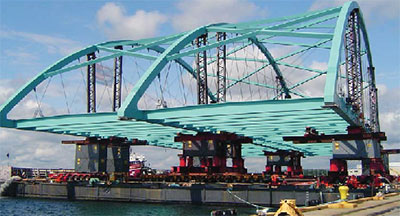Keep America Moving During Bridge Construction
American Association of State Highway and Transportation Officials
AASHTO
"GET IN, DO IT RIGHT, GET OUT, AND STAY OUT"
has become a rallying cry for new technologies that accelerate construction, minimize negative impacts on motorists, and improve worker and motorist safety.
The Federal Highway Administration (FHWA) has identified reducing construction related impacts to the traveling public as a major priority for the nation's highway program.
The use of self-propelled modular transporter (SPMT) technology provides agencies and contractors with the ultimate flexibility and speed in removing and installing bridge structures.
What is an SPMT?
A Self-Propelled Modular Transporter is a large multi-axle platform operated through a state-of-the-art computer control system that is capable of pivoting 360 degrees as needed to lift, carry, and set very large and heavy loads of many types. SPMTs are motorized vehicles that move at walking speed and are capable of carrying large structures, such as bridges, from offsite locations, positioning them precisely into final position. The SPMT then exits the site, returning the area to traffic use within minutes or hours.
Why SPMT? Why Now?
Significantly Reduce Traffic Disruption
SPMTs allow workers to remove or place whole bridge structures on busy roadways in just minutes or a few hours. Most of the complex - and often hazardous - work of building or removing structures in the path of existing traffic occurs offsite. Roadway interruptions occur only in the very brief windows of time in which a structure is being positioned for installation or carried offsite for demolition.

111-ft long, 25-ft high, 425-ton truss span installed over a weekend
Wells Street Bridge, Chicago 2002
Open Highways To Traffic In Hours
During conventional bridge construction, traffic that travels under the bridge is typically restricted during certain types of activity to protect motorist and worker safety. SPMTs can greatly reduce the duration of such interruptions.
| Work Operation | Duration | Traffic Control Method |
|---|---|---|
| Bridge Demolition | 2-3 days per span | Detour |
| Beam Placement | 25-90 minutes per beam | Rolling roadblocks or detour |
| Form Placement | Varies | Lane shifts/closure |
| Deck Concrete Placement | 1-2 days per span | Lane shifts/closure |
| Complete Removal or Placement | 25 minutes to a few hours per span | Single rolling roadblock or detour |
Improve Work Zone Safety
SPMT technology allows the prefabrication of structures in offsite staging areas, where construction crews can perform most of their work away from traffic. This improves the safety of the work environment and reduces the exposure of motorists to roadway work zone hazards. Significant worker safety benefits are also derived from the ability to work during the day without interruptions and near ground level throughout the construction process.
Improve Quality and Constructability
Since SPMTs allow bridges to be built in the controlled environment of an off-road site, the focus remains solely on construction rather than the need to accommodate traffic. In this environment the more uniform production capability with adequate time for proper concrete curing leads to consistent overall quality and constructability of the finished product.
Increase Contractor and Owner Options
SPMT technology fuels flexibility in choosing staging areas. Lifting the structure from below and "driving" it into (or out of) place eliminates many issues related to overhead height restrictions that impact crane lifting operations, while the supported SPMT loads provide added safety assurance relative to suspended crane loads.
Offsite staging allows the contractor to work in daylight and extend work hours as needed in a safer environment. For example, onsite foundation and substructure work can occur simultaneously with superstructure fabrication, saving significant construction time. The benefits of onsite construction speed can be further increased by driving in multi-span bridges complete with substructures.
SPMTs can also be used to relocate existing spans onto new foundations to accommodate mainline widening or new interchange configurations.
Finally, "mom and pop" construction companies can use this technology as readily as larger companies because SPMT vendors provide engineering services that assist contractors with specialty issues.

Assembled in staging area & barged to site on SPMTs
A Sample of Project and User Cost Savings
The cost of mobilizing SPMT technology is offset by significant project savings that may include:
- fewer and shorter maintenance-of-traffic setups
- shorter hours for law enforcement officers due to fewer rolling roadblocks
- time savings from fewer shift changes for construction crews
- the elimination of temporary detour construction and repair of long-term detours on existing roads
- the use of smaller owner and contractor crews
- reduced onsite time required for owner agency engineering and inspection requirements due to accelerated construction
- a vast reduction in the myriad user costs associated with construction-related delay, detour, and congestion
- less maintenance and repair costs associated with better long-term performance of the prefabricated structure.
- Contractors realize particular savings due to the significantly reduced onsite construction time. These may include:
- lower insurance premiums
- lower labor costs (for water work)
- increased volume of projects due to the speed of construction and installation
- reduced manpower costs
- reduced equipment rental time.

